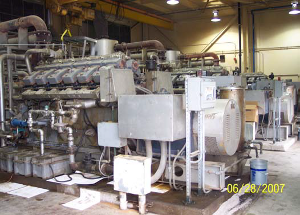Process Cooling of Engine/Generator Sets with Reuse Water
Jul 2008, Dr. Marcus N. Allhands, PE, VP Business Development Orival, Inc.
Figure 1. V-12 engine/generator sets.

Figure 2. Filtration system: Two Orival OR-12-PS filters with manifold.
One of several municipal waste water treatment plants (WWTP) in St. Louis is located along the banks of one of the largest tributaries to the Mississippi River. This 100 MGD (million gallons per day) facility has a large demand for service water with low suspended solids.
Nearly 3 MGD of water are needed for various on-site services but perhaps none as important as cooling large V-12 internal combustion engine/generator sets (Figure 1). These engines run off of methane gas produced on-site from the anaerobic sludge digestion process. The cooling process passes water one time through the engine blocks and then discharges the water back to the head of the WWTP. Therefore, this cooling water must be free of organic and inorganic particles that could interfere with heat transfer at the engine wall/water interface. The power produced by these engines can supply nearly all the electricity needed to run the entire wastewater treatment plant. However, if the engines overheat, safety controls shut down the engines and stop electricity production until the cooling problem can be solved. This immediately switches all power necessary to run the myriad of motors on pumps, aeration blowers, sludge presses and automated treatment equipment to purchased electricity. If this cooling process were to use potable water, as in many other facilities, the cost of this cooling water would nearly offset the savings of on-site power generation. An automatic self-cleaning screen filtration system provided by Orival, Inc. was installed recently using effluent from the wastewater treatment process for this non-potable cooling requirement saving enough potable water each day to supply an additional 500 homes in the area.
There have been no engine cooling problems since the Orival automatic filtration water reuse system began operating.
Figure 2 shows the operating installation of the reuse system provided by Orival, Inc. as a complete package with filters, controls, manifold and valves. The controller initiates a cleaning cycle when a preset pressure loss occurs across the filtration system or by a manually set timer in the control panel. The pressure in the filter rinse chamber is greatly reduced by opening a valve to atmospheric pressure. The differential pressure between the water being pumped through the filtration system and atmospheric pressure causes a high velocity flow of water to pass through the screen cleaning mechanism called the dirt collector. The dirt collector rotates and moves linearly using the hydraulics of the water flowing in the system. This mechanism thoroughly vacuums debris from every square inch of the screen's surface in less than 15 seconds without interrupting the filtration process. There have been no engine cooling problems since the Orival automatic filtration water reuse system began operating.